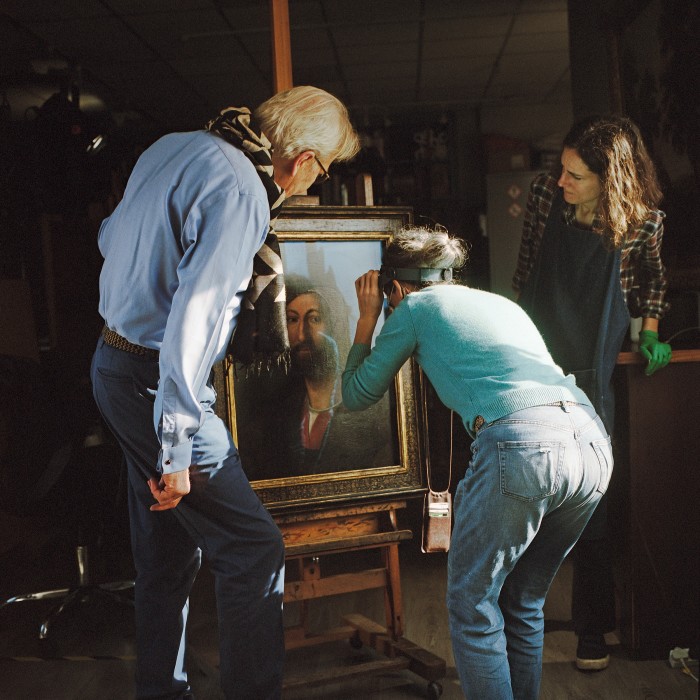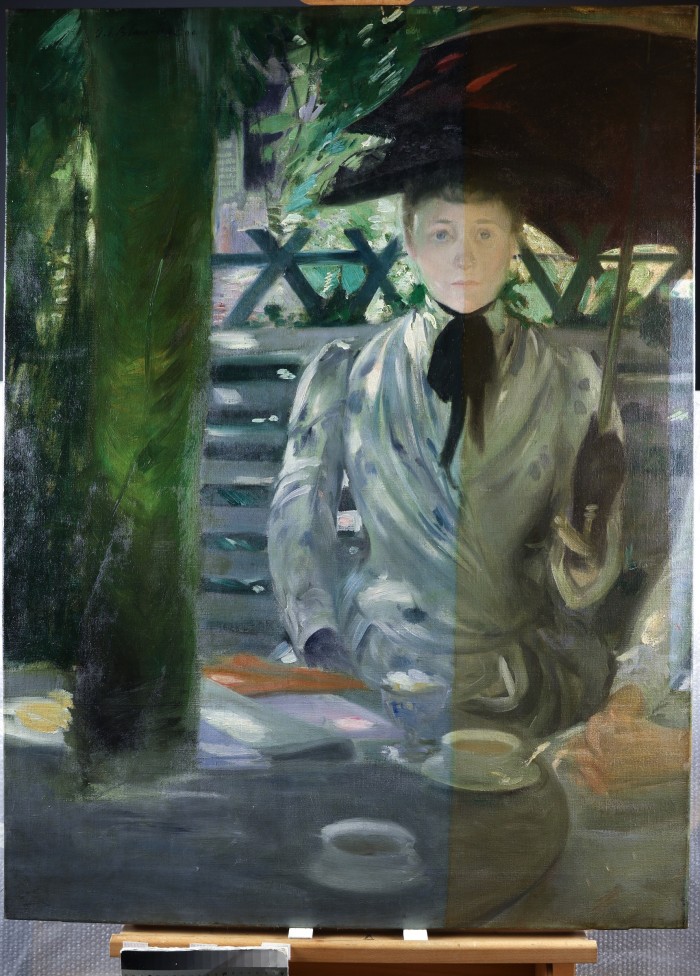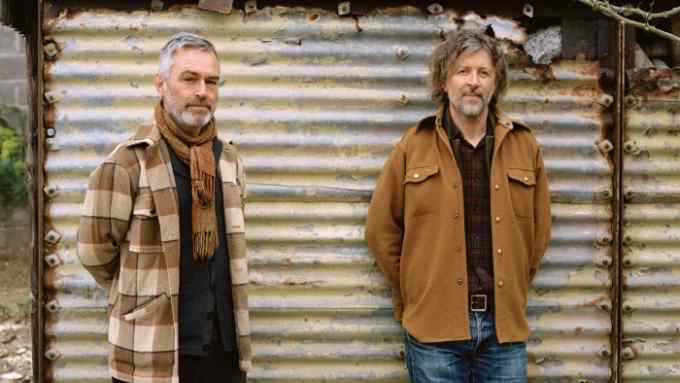‘We think it might be a Raphael’: the secret art of restoration

Simply sign up to the Arts myFT Digest -- delivered directly to your inbox.
Simon Gillespie will be speaking at “Portraiture, power and politics: art and the society of now” at the FT Weekend Festival on September 4; ftweekendfestival.com
There is a monastic silence inside Simon Gillespie’s art-restoration studio in Mayfair as he ushers me around, quietly introducing me to members of his team. They are rapt in concentration, each one scrutinising the artwork before them, occasionally applying the gentlest of touches with a brush. I remark on the striking quality of what looks like a Renaissance portrait that is being worked on, and he nods in agreement. After a short pause, he says: “We think it might be a Raphael.”
He drops the phrase casually, as if it is no big deal. But of course it is a big deal, because “new” paintings by the Italian Master are not found every day; and it is an exceptionally big deal for the client who has brought the painting into the studio to be restored, because its monetary value may be about to vault into the seven-figure realm, and he or she is going to need an insurance-policy upgrade.
If any of this weighs heavily on Gillespie’s mind, he hides it well. Naturally he doesn’t name the client, and he also asks me not to describe the painting for reasons of confidentiality. He is more interested in pointing out the features of the work that support his tentative theory: the vibrancy of the colours, the clarity of the composition, the art-historical background.

When the client first brought it in, I ask him, was there any mention of Raphael? “No,” he replies instantly. But he just looked at it and sensed something? His look tells me it is not quite so simple. “The days of the expert walking into the room and feeling a slight twist of the stomach and saying, ‘Yes, this is a Rembrandt’, and then the next day having a bad day and saying, ‘No it isn’t’, and walking out” – he clicks his finger with disdain – “it just doesn’t work like that any more.”
Gillespie’s taciturn studio, which he established in 1982, has become one of the world’s leading restoration centres for ailing, damaged or just plain dirty artistic treasures. His expertise is sought by collectors, auction houses and some of the world’s finest museums. They ask him to bring new life to pictures whose glories have faded or which have been neglected, and, in some cases, help identify the artists who produced them. Most of his time is spent on Old Masters, but he also treats contemporary art, even advising artists on ensuring the healthy longevity of their work.
Gillespie’s work is highly scientific, involving an array of meticulously designed instruments and X-ray technology that, he says, are used to fill in his “menu of tick-boxes”. It doesn’t help him instantly to identify a masterpiece, but it can exclude the possibility. “If a Rembrandt has a portrait of Mussolini underneath it, then we know it is not right,” he says, slightly surreally. “If we find it has the wrong pigments in it, which were invented many years later, we know it is not right. We go through the hoops before we can say, ‘Yes, it does fit.’” Thanks to the new scientific techniques, he estimates that up to half of his time is taken up these days with attribution work.
Gillespie is tall, aristocratic and speaks in a clipped, softly spoken tone that can make it hard to detect when he tells a joke. But he suddenly becomes animated, and deadly serious. “Every time I do this, it gives me a thrill,” he says. “To go through these layers of dirt, nicotine, woodsmoke, candle that have been there for 200 to 300 years. And then finding something that has been hidden from us for all that time.” It must be an exciting moment, I say. “Very exciting. I get up in the morning and think, ‘What am I going to do today? Oh, there’s that portrait by Raphael. Fuck, let’s get out of bed!’”

“I wasn’t very good at anything else,” Gillespie replies, frankly, when I ask him how he became a restorer. “Both sides of my family for generations had been in the military, and it was automatically expected that I would be joining in.” A very brief spell with the Royal Marines dissuaded him from his presumed vocation. “I asked the silly question of why did I need to polish my boots? They didn’t get on with me, I didn’t get on with them.”
He says his father “raised an eyebrow” when he mentioned a newly fledged interest in art, but “became very practical, and helped me to get a start”. A stint at a furniture shop while living in Somerset piqued his interest in art restoration; a stay in Mexico with this then-wife provided the epiphanic moment that set him on his way. “Somebody heard that I knew how to restore antiques and brought a picture to me. I took it to a picture restorer and he seemed to be treating it with such disdain, I thought this was not how this wonderful object should be treated. And then suddenly a lightbulb went off.” On his return to London, he devoted himself to a series of courses on chemistry and art history. “Those two things are very important to mix,” he stresses.

The success of Gillespie’s practice is testament to the burgeoning professionalisation of art restoration and conservation. He waves towards his fellow workers: “They are far more trained than I am.” Even interns applying to work at the studio require a postgraduate degree in easel-paintings conservation “from a reputable institution” to make the grade.
Despite the demands of running the business, Gillespie says he still finds private moments of wonderment in his daily engagement with the treasures he has been tasked to rescue. One evening he was working on a self-portrait by one of his favourite artists, the Dutch Master Frans Hals, and found himself enraptured in his labours. “There I was, just sitting there, with him looking straight at me, and I was using the same little muscle movements as he did all those years ago. I thought I had been there for about an hour, and then my wife called me at midnight and said, ‘Where the hell are you?’
“I was shocked. It was the closest thing to time travel. I could feel him right there, on my shoulder. It was a spooky, spooky moment. And a lovely moment.”

Over the past few years, Gillespie has acquired small but notable celebrity status thanks to the success of the BBC TV show Britain’s Lost Masterpieces, a documentary detective series in which he stars with the art historian Bendor Grosvenor and the academic Emma Dabiri, devoted to the unearthing of important paintings previously misattributed or neglected. Gillespie and Grosvenor are like “two little boys in a magical world”, says Harry Bell, the show’s executive producer. “They’re so in love with what they do.” Among the pair’s successes have been the unveiling of works freshly attributed to Titian at Petworth House in West Sussex, and to the workshop of Sandro Botticelli at National Museum Wales.
The show works in close conjunction with the National Trust, which has subsequently seen a growing interest in its art collections. Whenever one of its properties finds it has a newly assessed masterpiece on its hands, visitor numbers pick up sharply, says Marion Richards, art detective manager at Art UK (a charity and the online home for every public-art collection in the UK), who believes that Gillespie has played a key role in the democratisation of art detective work.
The show mainly deals with publicly owned work, but its focus on the issue of artistic authorship has coincided with the uncovering of several high-profile cases of artistic fraud in the international art market. Last year’s Netflix documentary Made You Look: A True Story about Fake Art investigated one of the most prominent of these, outlining the execution of an $80m scam in which fake abstract expressionist “masterpieces” were introduced into the market without detection.
Gillespie concedes that art forgery is a blight on the art world. “There are some really, really good fakers around,” he says, almost in admiration. “I’m sure some of them have got past me, if I’m not really looking out for it. The general faker gives himself away. He is egotistical, he writes a book about it, he tells someone in a museum, ‘Actually, you’ve got one of mine there.’ And then he gets arrested.

“And then there are the good ones. The good ones don’t get arrested. There is a faker in Italy at the moment,” he says, undemonstrative, “and he has been [forging] art from across the board, across the centuries. His knowledge of his materials must be huge. And not only does he find them, he puts them together in the way the artist did. He’s obviously studied how that happens. Maybe,” he says drily, “he’s a restorer.”
Showing no obvious signs of wanting to give up the day job for a life of crime, Gillespie explains some of the technical – and occasionally ethical – intricacies involved in his craft. Most of the damage done to paintings is by overpainting from well-meaning restorers, particularly from the 19th century, he says: “They were local craftsmen who would take out a large brush and go over the whole thing.” While that added layer of paint is removable, greater damage is done to a painting that has been overcleaned.
“When that happens, you lose the top quarter of a per cent of the surface. That is enough to be a serious defamation, taking away the originality and finesse of the picture.” It is those negative, over-tentative attributions in the past that have caused paintings to lose their “position”, he says, leading to them ending up in the basements of stately homes.
Of these works that are identified and brought back to something closer to their original state, one of the most “extraordinary” transformations, says Gillespie, came after an investigation of a painting of an agricultural scene from Birmingham Museums, Autumn, not seen in public in decades. The picture was found to have an added layer of paint, showing dense woodland, across half of its surface. Once it was removed, a rather different scene emerged, and was attributed to the Flemish late-16th/early-17th-century landscapist Joos de Momper, with additional figures painted in the studio of Jan Brueghel the Elder.

The overprinting was possibly done in the 18th century, says Gillespie. “It was so audacious! He obviously thought he could do a better job than what was there before.” He said the process of the painting’s rehabilitation was “like being a foxhound going down a rabbit hole”.
Discovery does not entail reattribution, however. Once paintings have passed Gillespie’s checklist, they need to earn a positive verdict from academic specialists on the painter in question. “It takes a lot of persuasion to get everyone on board,” he says. I ask him if the judgement needs to be unanimous. “No. But that is when you can get litigation and it all goes wrong. It’s always easier to say, ‘No’.” Some of the most difficult moments occur when an inspired client has to be told that their painting is not a masterpiece at all. “They find it in an attic, bring it in in a mile of bubble wrap, and I have to sit them down and say, ‘I’m sorry, there is a Mussolini portrait under your Rembrandt’, and then pick them off the floor.”
Dashing their hopes is uncomfortable, he says. “But then we give the picture some hope, when it comes in all bedraggled, and we bring it back to life.” He points to a large painting in his office that he has recently helped attribute to an Old Master. “It came in looking like it had had an armchair thrown through it in a pub brawl,” he says. Even when a client is disappointed, he says the process is illuminating for all involved. “They want to find out more, I want to learn more, and we teach each other.”
Part of that learning process, he says, involves the acquiring of judgement. He recounts an example, from when a collector brought a Picasso painting to the studio. “There were two or three drips on the picture. It looked like they might have been meant to be there, but it’s not really the type of thing you expect from Picasso.
“So we looked through the books, and found a black-and-white photograph showing Picasso leaning against the picture with a cup of coffee in his hand, in his studio. The drip was on the painting. Now, did he drip the coffee on the painting? We don’t know. I did take a wet swab, attempted to clean it, just a tiny, tiny bit. And it came off quite easily. And there was an instant smell of coffee!”
Did they decide to leave the drip? “We did. Because,” he says with added emphasis, “it is part of its history.”

Comments